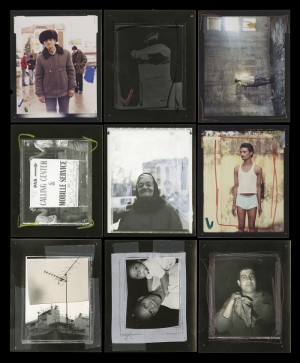The ICP Triennial: A Different Kind of Disorder
Another “mapper” brings the after-effects of the 2011 nuclear disaster in Fukushima, Japan front and center. Photographer Shimpei Takeda placed radioactive soil from the affected area in contact with photo-sensitive sheets of film. These “autoradiographs” appear to document solar galaxies when they are simply impressions of radiation emitted by the contaminated particles. This series entitled Trace, makes us question whether we can comfortably consider such creations or impressions as art unhinged from their larger social context.
Creating and altering black and white images out of calamitous smoke billows for her series, Smoke, New York photographer Lisa Oppenheim creates images reminiscent of Alfred Stieglitz’s Equivalents. They are aesthetically powerful but retain captions to remind us of their origin. Sam Falls traveled to California’s Mojave Desert, photographing abandoned sheds with his own hand-dyed fabric in windows and doorways. The sky was then hand rolled with enamel paint. He wrapped boulders in linen, leaving them in the sun for several months until the sunlight blurred the outline of the rock into the fabric. Falls calls these photograms “formed over time, rather than captured in an instant.” Experimentation for experimentation’s sake would seem the rule of order here.
Videos play an integral role in this exhibit, running the gamut from documenting humanitarian crises where they occur to the most self-referential and experimental. One of the best examples of the former can be found in Londoner Gideon Mendel’s project, Drowning World. In light of our global concerns about climate change, his tracking since 2007 of flood activity around the world is a true eye-opener. In poor countries where the means to clean and rebuild are almost non-existent, we watch the semi-submerged victims carry on with their daily lives, selling produce, grilling takeaway meats, while brackish water slaps around their knees. A series of stills from the video fill the adjoining walls — solitary and numbing portraits of the same subjects.
Some ICP visitors appeared benumbed by what seemed to be an almost mute acceptance on the part of these villagers, particularly in the Bangkok segment. What kind of response do we see conveyed by these villagers? Is it stoicism or shock? Mendel’s career as a photojournalist has taken him from anti-apartheid struggle in South Africa, then AIDS, to his present day obsession with the environment.
Mendel’s role as a collaborator in the all-too human struggle to survive is echoed in San Franciscan Jim Goldberg’s photo storytelling. His Open See book documents migrants and the unique experience of dislocation. Not unlike the lightboxes of the Ponte City project, this sea of humanity in distress leaves it up to the viewer to dissect. But the images are even rawer. A girl of 14 holds a Barbie doll in front of her face. Scrawled across the photo is her message for us: “I left Moldavia for Turkey…I stayed three days, beaten, drugged…sold me to Greece man for sex and money. Now I in Greece and free, thanks to good people.”
In light of such documentation, to confront the fetish-like videos of Brooklyn-based A.K. Burns requires a quantum-leap from primal empathy to bemused and objective tolerance. As she reenacts YouTube segments on a five-channel video installation entitled Touch Parade, we witness the artist crushing eggs underfoot, inflating a balloon until it pops, and even driving a stick-shift car barefoot. The artist can’t be faulted, of course, for what feels in such an emotionally-charged exhibit like deeply personal, naval-gazing exercises.
Another form of disorientation occurs when entering Tel Aviv artist Nir Evron’s black box room environment where his film, A Free Moment, looks down on the city of Jerusalem. The camera tilts and pans in a 360-degree circle while traveling from one end of a dolly track to the other, the same track installed with a robotic camera. Its purposeful disorientation (those with motion sickness beware) and not a totally unfamiliar sensation to the many filmgoers among us. Still, it magnetizes.
Nayland Blake’s Knee Deep in the Flooded Victory gives voice to street activism and the gay liberation movement. The movement’s marginal beginnings as part of the Times Square vanished adult theatres and cruising spots are touched upon but may elude some visitors unfamiliar with the specific history of the time. Incorporating zines from his students at the ICP/Bard MFA program, the café and downstairs bathrooms are transformed into a crowded corner that may discourage some, given the spatial airiness of the exhibit as a whole. (The day I visited, a janitor was working in one of the restrooms and redirected confused patrons to the upstairs facilities.) Blake’s alternate persona, Victoria Spectre, will take tourists on a tour reminiscent of those days as part of a July 12th performance.
With a nod to the self-publishing boom in photography books, the exhibit includes an installation of several noteworthy examples. On the first floor a mobile staircase leads to a narrow platform where the curious can peruse the publications, but it is almost missed when focusing on the rich array of wall exhibits nearby.
Unquestionably, there is something for everyone’s taste in this triennial. As poet and essayist George Santayana so aptly put it, “an artist is a dreamer consenting to dream of the actual world.” Here, we are given the actual world, troubled as that might be. It is transformed, perhaps, but reminding us of our shared humanity.
(The ICP Triennial will be on view at The International Center of Photography, located at 1133 Avenue of the Americas at 43rd Street, New York, NY, 10036 through September 8, 2013. For more information, call 212-857-0090 or visit http://www.icp.org/. )
Featured image: Jim Goldberg, “Proof (detail),” 2011. Courtesy the artist. Photo Courtesy of: The ICP.


